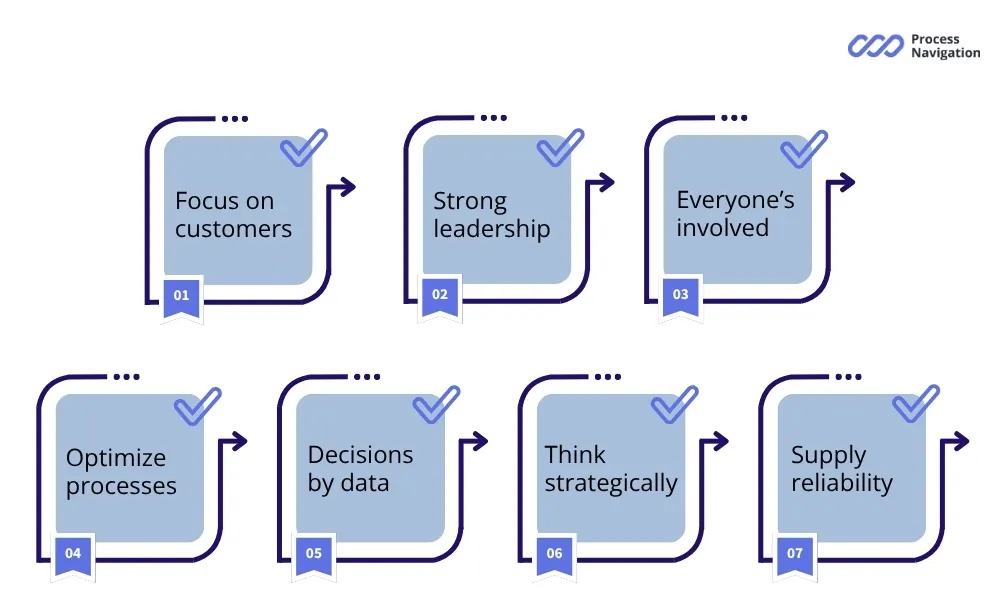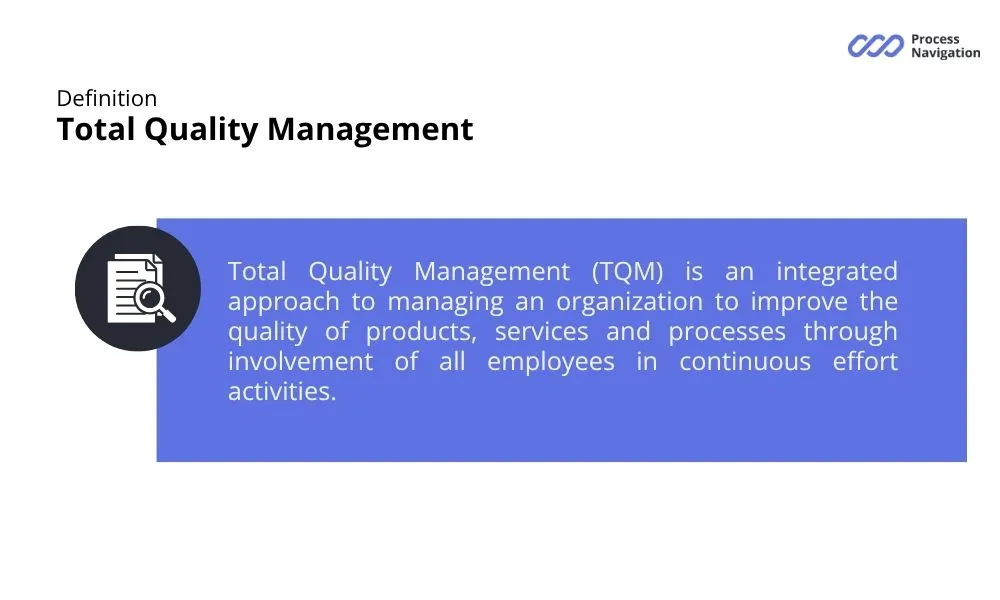In today’s competitive world, the quality of products and services is becoming the key to success of any company. Total Quality Management (TQM) is not just a set of tools, but a business philosophy that helps you achieve long term success through a strategic and systematic approach to quality management.
TQM integrates all aspects of an organization’s activities from strategic planning to operational processes to achieve maximum customer satisfaction. This is an integrated system where each employee knows their role in delivering quality and creating value for the customer.
Total Quality Management systems have been adopted across many industries including manufacturing, healthcare and service sectors because they streamline processes, deliver efficiency, cost reduction and overall quality management improvement.
Total Quality Management Definition
Total Quality Management (TQM) is an integrated approach to managing an organization to improve the quality of products, services and processes through involvement of all employees in continuous effort activities.
The principles of TQM such as leadership, employee engagement, effective communication and systematic data analysis are key to creating a quality culture and aligning organizational goals with quality objectives.
Continual improvement is a core component of quality management, emphasizing that quality is a continuous process, not a one off achievement. By focusing on these total quality management TQM principles, organizations can achieve excellence and make quality part of their DNA.
What is total quality management in a practical sense? It is a system where:
- Quality is not seen as a separate function, but as everyone’s responsibility.
- Client-centered approach becomes the basis for all decisions.
- Continuous improvement becomes a daily practice.
- Employee involvement ensures sustainability of changes.
The TQM definition includes several fundamental elements:
| TQM elements | Explain TQM | Practical application |
| Total | Involvement of the entire organization | Each department participates in improvements |
| Quality | Meeting customer satisfaction | Quality is determined by the consumer |
| Management | Systems approach to management | Quality is planned and controlled |
Many experts often confuse Total Quality Management and Total Quality Control (TQC), since both approaches are aimed at ensuring quality. However, there are fundamental differences between them.
TQC (Total Quality Control) is a technical approach focused on product quality control through inspection, testing, and statistical methods. TQC focuses on identifying and correcting defects, usually by specialized quality departments.
TQM (Total Quality Management) is a philosophy of managing the entire organization, where quality becomes the responsibility of each employee. TQM emphasizes problem prevention through continuous effort, customer focus, active management participation, and cross functional teams.
The main difference: TQC asks “How to find and correct defects?”, while TQM asks “How to create a system that does not allow defects to appear?”. TQC is a control tool, TQM is a quality culture for the entire company.
TQM vs TQC: Key Differences
| Aspect | TQM | TQC |
| Scope | Organization-wide and holistic scope | Focused on specific processes or departments |
| Approach | Proactive, emphasizing continuous improvement | Often reactive, focusing on defect prevention |
| Employee Involvement | Involves all employees in the quality process | Manages primarily by quality control specialist |
| Customer focus | Strong emphasis on customer satisfaction | Focuses more on meeting technical specifications and standards |
Main Principles of Total Quality Management

TQM isn’t just a set of rules — it’s a management philosophy that helps organizations deliver high quality products and services while fostering a culture of continuous improvement. At its heart TQM is about putting the customer first, empowering employees and optimizing every process to eliminate waste and inefficiency.
Here’s a deeper look at the key principles that make TQM work:
1. Customer Focus
It means that all processes in the company should be aimed at creating value for the customer. Quality isn’t defined by the company — it’s defined by the consumer. Understanding their needs, expectations and even unspoken preferences is crucial.
2. Leadership Commitment
Successful implementation of TQM is impossible without the active participation of top management. Managers must not only declare the importance of quality, but also demonstrate it by personal example.
3. Total Employee Involvement
Quality isn’t just the responsibility of management or a dedicated “quality control” team. From frontline workers to executives, TQM encourages a culture where everyone is empowered to identify problems, suggest improvements and take ownership of quality.
4. Process-Centric Approach
Inconsistent processes lead to inconsistent results. TQM emphasizes standardization, optimization and documentation of workflows to ensure reliability. By mapping out processes, identifying bottlenecks and refining them, businesses can reduce errors, save time and improve output quality.
5. Data-Driven Decision Making
Gut feelings and guesswork aren’t enough. TQM relies on statistical analysis, KPIs and real-time data to identify trends, measure performance and drive improvements. Tools like Six Sigma, Pareto charts and control charts help turn raw data into actionable insights.
6. Strategic and Systematic Thinking
Quality shouldn’t be an afterthought — it must be woven into the long term strategy of the organization. TQM aligns quality objectives with business goals, so every department works towards the same vision. Leadership commitment is essential to sustain this mindset at all levels.
7. Mutually Beneficial Supplier Relationships
A company’s quality is only as strong as its supply chain. TQM promotes strong partnerships with suppliers, so materials and services meet quality standards. Collaborative relationships — rather than adversarial price negotiations — lead to better reliability, innovation and shared success.
Implementing these principles means adopting TQM practices that simplify things, improve efficiency and drive continuous improvement.
Methodologies Based on TQM Principles
TQM laid the foundation for the spread of modern approaches to quality management. Understanding the relationship between TQM and scientific methodologies will help determine the development path of your company.

Six Sigma — A Statistical Approach to Quality
Six Sigma took TQM as a basis and added mathematical rigor. If TQM says “improve quality”, then Six Sigma answers “how” — through statistical analysis and DMAIC (Define-Measure-Analyze-Improve-Control) projects.
ISO 9000 Series — International Quality Standards
The ISO 9000 series turned the TQM philosophy into specific requirements that any company can implement. It is a kind of “TQM textbook” for business. Over a million companies worldwide have received ISO 9001 certification, based on the principles of customer focus and process approach.
Kaizen Events — Japanese Practice of Continuous Improvement
Kaizen events are a practical implementation of the principles of continuous improvement TQM. Instead of reorganizing large projects, the company carries out many small improvements.
Benefits of Total Quality Management
TQM has many advantages and can make a big difference to your business. Here are some of the key ones:
- Higher Customer Satisfaction: Meet customer expectations and get repeat business, new customers, and foster satisfied customers.
- More Efficient: Streamline and reduce waste.
- Employee Engagement: A quality culture makes employees perform better and take pride in their work.
- Competitive Advantage: High quality products and services set you apart from the competition.
- Cost Savings: Lower defect rates mean cost savings in production and service delivery.
- Compliance: TQM organizations are compliant and avoid legal issues.
- Innovation Boost: A continuous improvement in culture means innovation and creative problem solving.
Total Quality Management Implementation
Let’s be honest, most quality initiatives fail because they feel like corporate checklists rather than real changes.
TQM is different when done right. It’s not about fancy jargon or binders collecting dust on shelves. It’s about changing how everyone in your company thinks about their work every single day. Here’s how to make it stick:
| Stage | Explanation |
| 1. Get your leaders all in | Real change starts when leadership:Puts quality goals ahead of short-term profits (yes, really).Shows up on the shop floor or in department meetings.Actually uses the same systems they’re asking employees to adopt. |
| 2. Teach people what good looks like | You can’t expect people to improve if they don’t know how. Skip the boring PowerPoints and try:Hands-on problem solving sessions where teams fix real issues.Cross-training so people understand how their work affects others.Simple tools everyone can use daily, not just quality specialists. |
| 3. Map out your mess | Every company has broken processes everyone just works around. Time to:Draw out how work actually flows.Hunt down the bottlenecks that drive everyone crazy.Steal ideas from companies doing it better. |
| 4. Actually listen to customers | Not just surveys that go unanswered. Get creative:Have employees call recent customers.Track complaints like gold — each one’s a free improvement idea.Shop your own company to feel the customer pain points. |
| 5. Measure what matters | Forget tracking 50 metrics. Pick 3-5 that actually show if you’re getting better, like:How often do you screw up (defect rates)?How fast do you deliver?Whether customers would recommend you (the ultimate test)? |
| 6. Make improvement everyone’s daily habit | This isn’t a “quality program” — it’s how you work now:Quick daily huddles to fix yesterday’s issues.Test small changes before big rollouts.Celebrate the people who spot problems. |
| 7. Tear down the department walls | Silos kill quality. Try:Mixed teams tackling cross-company problems.Job rotations so people understand other roles.Shared goals that force collaboration. |
TQM works when it stops being “extra work” and just becomes “how we do things here.” Start with one area, show quick wins and let success build on itself. Before you know it your people will be finding and fixing problems before you even see them.
Total Quality Management Сhallenges
Despite the benefits TQM can bring, there are obstacles to overcome. Here are some of them:
- Resistance to Change: Staff will resist new processes because of extra work or not knowing TQM.
- Lack of Management Buy In: Without leadership commitment TQM will not take off.
- Insufficient Training: Staff need training to understand and implement TQM.
- Poor Communication: Lack of clear communication will lead to misunderstandings and inconsistent quality practices.
- Resource Constraints: Implementing TQM requires investment in training, technology and process improvements.
- Measuring Success: Measuring TQM activity can be hard without the right metrics.
Understanding and applying principles of TQM like leadership, employee engagement, communication and systematic data analysis will help you overcome these issues and build a quality culture.
Future Trends
As industries evolve, TQM is evolving with them:
- Digital Transformation: Companies are integrating AI, IoT and automation to improve quality control.
- Green Quality Management: TQM is aligning with sustainability to reduce environmental impact.
- Data-Driven Quality Improvement: Advanced analytics and big data is enhancing decision making in quality management.
- Agile Quality Management: Businesses are adopting agile to improve responsiveness and adaptability.
- Remote Quality Assurance: With remote work on the rise, organizations are developing strategies to maintain quality standards virtually.
- AI and Machine Learning in Quality Control: AI models are being used to detect defects and optimize processes in real-time.
Modern quality control is being integrated with new technologies to ensure excellence in business processes.
TQM is a must for any business to win. Through continuous improvement, customer satisfaction and employee involvement a business can succeed in the long run. TQM requires commitment and a plan but the returns are worth the hard work. Businesses that adopt TQM not only improve their products and services but get a competitive edge.
In summary TQM is a powerful tool that can turn a business upside down by instilling a quality culture and continuous improvement. By focusing on customer satisfaction, employee involvement and process optimization a business can grow and stay ahead. As industries change the principles of TQM will remain relevant and guide businesses to excellence and long term success.
FAQ
TQM is a broader philosophy that encompasses the entire culture of an organization. Six Sigma is a specific methodology that focuses on statistical analysis and reducing process variability. Many companies successfully combine both approaches.
No, TQM principles are applicable in any field. For example, in medicine — to reduce medical errors, in education — to improve training quality, in service sector — to improve customer satisfaction.
No, TQM and Kaizen are not the same, though they are related. TQM is a comprehensive management approach focused on long-term quality improvement across the entire organization, while Kaizen emphasizes continuous, incremental improvements in daily processes. Kaizen can be seen as one of the tools or practices that supports the broader TQM philosophy.
By identifying inefficiencies, eliminating rework, and minimizing waste, TQM helps companies cut operational costs. Improved processes also lead to fewer customer complaints and warranty claims, which further reduces expenses.
Absolutely. TQM is not limited to large corporations. Small and medium-sized enterprises can use its principles to improve service quality, optimize operations, and build stronger relationships with customers, often with faster results due to their agility.
-
 Maintenance Plan: What Is It And How Does It Work
Maintenance Plan: What Is It And How Does It WorkIn modern manufacturing, equipment downtime costs businesses thousands of dollars an hour. The difference between...
Technology
-
 Competency Management
Competency ManagementModern businesses face a big challenge: how do you ensure every employee has the skills...
Technology
-
 Unlocking the Benefits of Total Quality Management
Unlocking the Benefits of Total Quality ManagementIn today’s competitive world, the quality of products and services is becoming the key to...
Technology